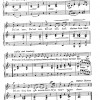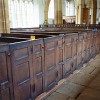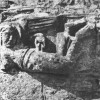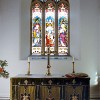Visitors to the Dorset resort of Lyme Regis in the 1820’s would most likely have noticed a diminutive brunette in a dark dress with cloak and bonnet, holding a basket in one hand and a claw-hammer in the other, picking her way over loose boulders wasted from the cliff. Probably they little realised that they were watching Mary Anning, and her business on the shore in those distant days was more than just a past time. The girl was out beach combing – not for the man made artefacts of her own time, but the astonishing profusion of fossils being weathered out by wind and waves from the wasting cliffs.
The girl began in a small way, collecting the numerous bivalves locally known as “Devil’s Toenails” (Gryphaea) and the bullet-shaped shells now known as belemnites (the skeleton of an early form of squid) but popularly called “Devil’s Thunderbolts.” Other popular names for the various fossils were “Ladies Fingers” “John Dories” or “Crocodile Bones.”
Mary was born in the town in 1799, the daughter of Richard Anning, a man living a lowly existence as Lyme’s carpenter and cabinetmaker. The family was not wealthy, and Richard and his wife (also called Mary) and their two children spent much of the time living on parish relief. Looking for a means to supplement his income, Anning conceived the bright idea of collecting and washing the myriad fossils to be found along the beach, to sell to tourists. Daughter Mary was a bright girl who took an intense interest in her father’s collecting. Before she was ten years old, she too was going out onto the beach with hammer and basket, the intention being to increase her father’s sale stock displayed outside his shop. In these forays her brother Joseph was often to be seen at her side.
Her first big break however, came in 1810 when she was eleven. In that year Richard Anning and Joseph discovered what seemed to them to be the head of a crocodile, worked loose from a recent cliff-fall. The carpenter felt certain the rest of the skeleton must have been left behind in the cliff, so he advised Mary to watch out for it when out on her regular collecting forays. But only a few months later her father was dead. In the meantime Mary continued to collect from Black Ven and Charmouth beaches. Then four months after her father’s death a violent storm caused a landslide, and the much prized “crocodile” skeleton was revealed. Mary skilfully traced out the fossil, hiring help to transport it, but it was several years before the 30-foot long creature was reconstructed.
What Mary had found was the first in a series of marine vertebrate finds which would make her name. It was in fact an Ichthyosaur, a now extinct marine reptile of the Jurassic period. Mary sold the Ichthyosaur to a Mr Henley for £23, a man who in turn would later sell it to the British Museum for twice as much. The specimen is now in the Natural History Museum. Ichthyosaurs were reptiles with a dolphin-like body, paddles, a fish-like tail and large eyes, but without a neck.
The next big find came in 1811, when Mary and Joseph unearthed the first Plesiosaur, a creature broadly similar to Ichthyosaurs, but having a long flexible neck and larger rear paddles. It could reach up to 40 feet in length. This skeleton first went to a natural history museum in Piccadilly before being purchased by the British Museum in 1819. In 1824 Mary made the discovery of the first Plesiosaur in perfect condition, though this specimen was much smaller than 40 feet. She sold this specimen for £120 guineas.
But there was to be another remarkable find in 1828; not a sea reptile this time, but a flying one. With a wingspan of 4 feet (up to 26 feet in an adult) this was the first Pterosaur, a creature called Dimorphodon, to be discovered virtually in tact. The fourth finger of each hand was elongated and supported a flight membrane. Dimorphodon probably flew by gliding.
Mary made the last important discovery in 1832, when another fine specimen of a 30-foot Ichthyosaur emerged from the Jurassic clay on the shore. On this occasion an amateur was accompanying her. This is now in the Natural History Museum, Kensington.
The fulcrum of Mary Anning’s collecting and discoveries was principally the need to make a living in hard times. As she searched Mary encountered many other people higher up the social scale than herself, who were nevertheless interested in her work. The Annings were poor, but on one occasion they did have a lucky break when Lt.Col. Birch of Thorpe Hall in Lincolnshire, hearing of Mary’s work and the family’s plight, gave the Annings £400 from the sale of his own fossil collection. She made the friendship of two sisters called Philpott, who often came to Lyme Regis to collect fossils themselves. Two men in particular, Sir Henry De la Beche, who founded the Geological Museum and School of Mines, and William Buckland, a clerical West Country geologist were influential in winning for Mary her enduring reputation and success.
In Mary’s day Lyme was becoming a popular resort and collectors were finding rare curiosities. The Anning fossils were regularly being bought by visitors arriving off the horse-coaches at the Pilot Inn. But the growing interest in the ancient animal remains was at a time when geological knowledge was in its infancy and very much framed within literal interpretation of the Bible and Creationist orthodoxy. The fossils being collected by Mary Anning and others were considered to represent thousands rather than millions of years, or were perhaps the remains of creatures, which perished in Noah’s Flood. Over the course of her short life, Mary’s work would make her well known and respected by many famous geologists of the day. She was aware – possibly ahead of her time – that fossils were not just curiosities, but were things of greater significance in the understanding of life on earth in its remoter antiquity.
Mary’s later years were spent in relative comfort. But she had never been robust, and by 1845 she had become morose and ill tempered, a trait which may have led to her becoming a lone beachcomber. The underlying cause of her disagreeable nature was probably the cancer, which was eventually to kill her. Nevertheless, this did not prevent her worth being appreciated by the scientific establishment, and she was elected a member of the Geological Society in recognition of her help to geologists of her day.
After her death in 1847 a stained glass window was dedicated to her memory in Lyme Church.



